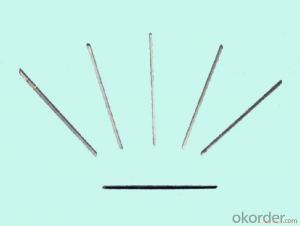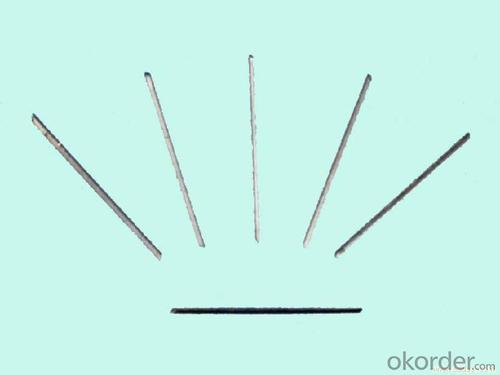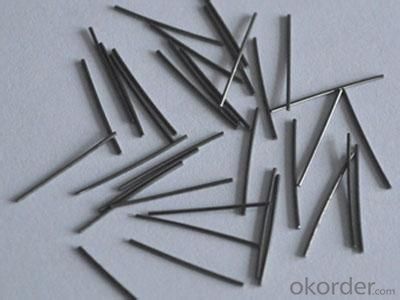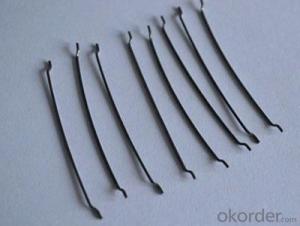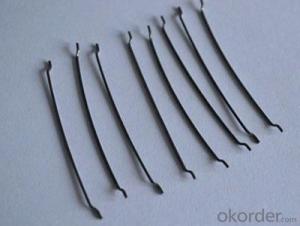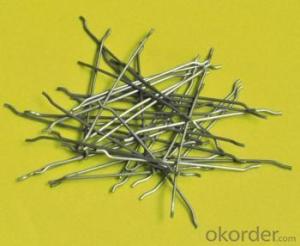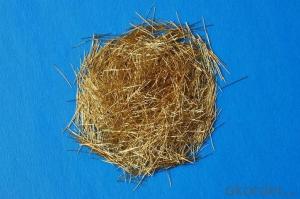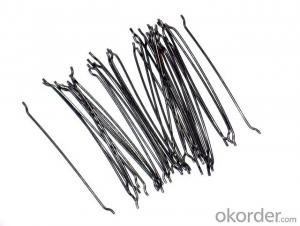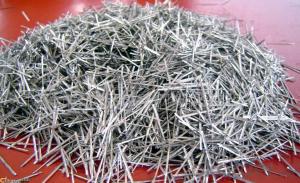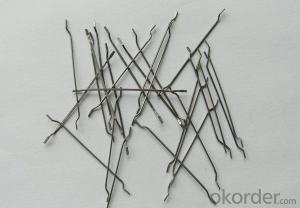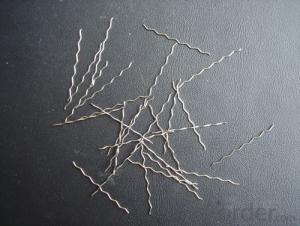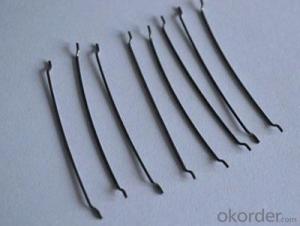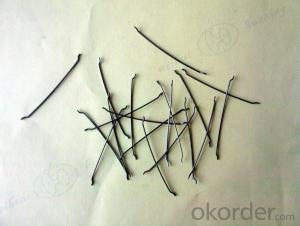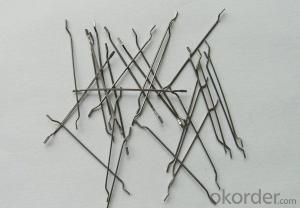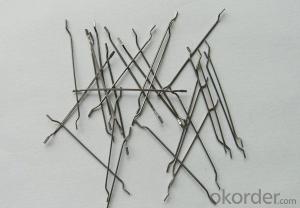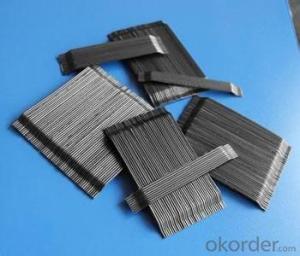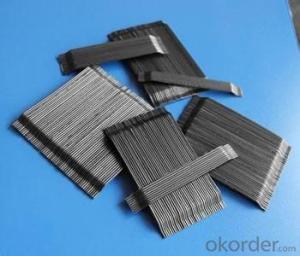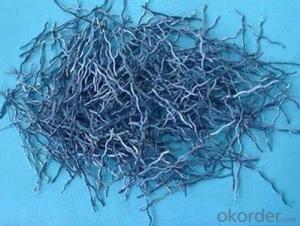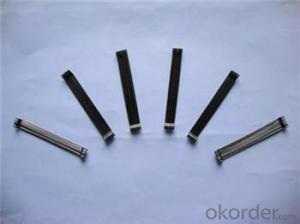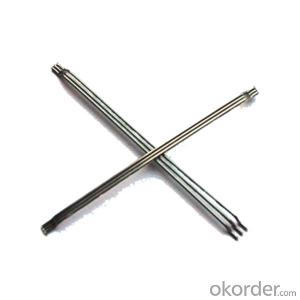Melt Extract Stainless Steel Fiber - Straight Type Steel Fiber by CNBM International China
- Loading Port:
- Tianjin
- Payment Terms:
- TT OR LC
- Min Order Qty:
- 1000 kg
- Supply Capability:
- 30000 kg/month
OKorder Service Pledge
OKorder Financial Service
You Might Also Like
Quick Details
Place of Origin: Jiangsu, China (Mainland)
Model Number: HT-ST
Material: Steel
Specifications
ISO 9001 certificated
2.70% for Europe, Middle Asia, America market
3.Have the most number of steel fiber machine in china
1. Material: low carbon steel wire or stainless steel
2.Diameter: 0.4mm-1.0mm
3.Length: meet your requirements
4.tensile strength >1000Mpa
6.Feature: excellent tensile,high tenacity,against cracking,impact and fatigue
7.Uses: highway road surface,tunnel,building,airport road surface and so on .
Straight Steel Fiber
1.ISO 9001 certificated
2.70% for Europe, Middle Asia, America market
3.Have the most number of steel fiber machine in china
Picture
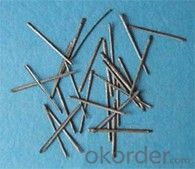
Steel fiber straight type
FAQ
certificated: ISO 9001
Technical advantages of Daye steel fiber:
A. Improve mechanical performance of concrete
B. Provide uniform distribution throughout concrete with excellent mixing
C. No balling or caking by adopt correct mixing method
D. Reduce concrete volume
E.Save construction time and cost
F.Reduce excavation volume
G.Available for jointless floor.
- Q: Does melt extract stainless steel fiber improve the freeze-thaw resistance of concrete?
- Yes, melt extract stainless steel fiber does improve the freeze-thaw resistance of concrete.
- Q: Can melt extract stainless steel fiber be used in architectural precast elements?
- Indeed, architectural precast elements can make use of melt extract stainless steel fibers. These fibers are commonly incorporated into concrete mixes to enhance the strength, durability, and performance of the precast elements. During the batching process, the stainless steel fibers are typically added in small proportions by volume to the concrete mix. They serve to augment the flexural strength, impact resistance, and crack resistance of the precast elements. Moreover, the stainless steel fibers offer corrosion resistance, which is especially advantageous in architectural precast elements that may come into contact with severe environmental conditions or corrosive chemicals. In conclusion, the utilization of melt extract stainless steel fibers in architectural precast elements can yield structures of superior quality and prolonged lifespan.
- Q: Is melt extract stainless steel fiber compatible with all types of concrete surface finishes?
- Melt extract stainless steel fiber is compatible with most types of concrete surface finishes. However, it is important to note that the compatibility may vary depending on factors such as the specific type of concrete surface finish, the application method, and the desired outcome. In general, melt extract stainless steel fiber can be successfully used with various types of concrete surface finishes, including smooth finishes, exposed aggregate finishes, stamped finishes, and textured finishes. The fibers can enhance the durability, strength, and crack resistance of the concrete, making it suitable for a wide range of applications. However, it is recommended to consult with a concrete expert or manufacturer to ensure the compatibility of melt extract stainless steel fiber with a specific type of concrete surface finish. They can provide valuable insights and guidance on the optimal fiber dosage, mixing methods, and application techniques to achieve the desired results. Additionally, they can also help address any potential concerns or limitations related to the compatibility of the fiber with the chosen surface finish.
- Q: What is the effect of melt extract stainless steel fiber on the permeability of shotcrete?
- The effect of melt extract stainless steel fiber on the permeability of shotcrete is that it reduces the permeability of the material. The addition of these fibers helps to create a denser and more cohesive structure, minimizing the passage of water or other fluids through the shotcrete. This improvement in permeability can enhance the durability and performance of shotcrete in various applications, such as in underground construction or waterproofing.
- Q: What is the difference between melt extract stainless steel fiber and other types of steel fibers?
- Melt extract stainless steel fiber, also known as melt extract steel fiber, is a type of steel fiber that is made by melting stainless steel and then rapidly extracting it into fine fibers. This process results in fibers that have unique properties and characteristics compared to other types of steel fibers. One key difference between melt extract stainless steel fiber and other types of steel fibers is its enhanced corrosion resistance. Stainless steel is known for its ability to resist corrosion and oxidation, making melt extract stainless steel fibers highly resistant to rust and degradation over time. This makes them suitable for use in environments where exposure to moisture, chemicals, or other corrosive substances is common. Another difference is the increased tensile strength of melt extract stainless steel fibers. The rapid extraction process helps to align the steel molecules, resulting in fibers that are stronger and more durable compared to other types of steel fibers. This improved tensile strength makes melt extract stainless steel fibers ideal for reinforcing concrete or other materials that require high strength and durability. Furthermore, melt extract stainless steel fibers also exhibit excellent thermal conductivity and electrical conductivity. This property makes them suitable for applications where heat or electricity needs to be transferred efficiently. For example, melt extract stainless steel fibers can be used in heating elements, electromagnetic shielding, or as conductive reinforcement in composites. Lastly, melt extract stainless steel fibers have a smoother surface compared to other steel fibers. This smooth surface allows for better bonding with the surrounding matrix, such as concrete or resin, leading to improved load transfer and enhanced overall performance. The smoothness of the fibers also reduces the likelihood of fiber pull-out or fiber breakage, further increasing their effectiveness as reinforcement materials. In summary, melt extract stainless steel fibers differ from other types of steel fibers due to their enhanced corrosion resistance, increased tensile strength, excellent thermal and electrical conductivity, and smoother surface. These unique properties make them a preferred choice for various applications that require high-performance reinforcement materials.
- Q: Can melt extract stainless steel fiber be used in high-performance concrete applications?
- High-performance concrete can benefit from the inclusion of melt extract stainless steel fiber. These fibers possess excellent qualities such as high tensile strength, corrosion resistance, and durability. These characteristics make them suitable for use in concrete structures that face heavy loads, harsh weather conditions, or aggressive surroundings. To enhance the mechanical properties of high-performance concrete, it is common to incorporate stainless steel fibers. These fibers serve to enhance the concrete's resistance to cracking, bolster its flexural and tensile strength, and improve its ability to withstand impact and fatigue. Consequently, concrete with stainless steel fibers is well-suited for applications like bridge decks, industrial floors, tunnels, and other structures that require heightened strength and durability. Melt extract stainless steel fibers are produced through the process of melting stainless steel and promptly extracting it into fiber form. This manufacturing technique guarantees that the fibers possess a uniform diameter and a high aspect ratio, which further enhances their performance in high-performance concrete applications. To achieve the desired reinforcement effect, the fibers are typically added to the concrete mix in a specific dosage. The use of melt extract stainless steel fibers in high-performance concrete has been extensively researched and proven effective. Numerous studies and real-world applications have demonstrated that the inclusion of stainless steel fibers can significantly enhance the mechanical properties and durability of high-performance concrete. These fibers reduce cracking, increase load-bearing capacity, and overall improve the performance of concrete structures. However, it is crucial to properly evaluate and optimize the dosage of stainless steel fibers and the concrete mix design for each specific application. This ensures that the desired performance requirements are met without compromising other properties of the concrete mix, such as workability or finishability. In conclusion, melt extract stainless steel fiber is a viable choice for high-performance concrete applications. Its impressive tensile strength, corrosion resistance, and durability make it an excellent reinforcement material for structures that encounter heavy loads, harsh weather conditions, or aggressive environments. Careful consideration of dosage and mix design is essential to achieve the desired performance while maintaining the overall quality of the concrete.
- Q: Can melt extract stainless steel fiber be used in tunnel lining construction?
- Yes, melt extract stainless steel fiber can be used in tunnel lining construction. These fibers are commonly used as reinforcement in shotcrete applications for the lining of tunnels. They enhance the structural integrity and durability of the lining by improving crack resistance and reducing shrinkage. The stainless steel fibers have high tensile strength, corrosion resistance, and thermal stability, making them suitable for use in harsh tunnel environments. Additionally, they help to control spalling and enhance the overall performance of the tunnel lining.
- Q: How does melt extract stainless steel fiber affect the shear strength of concrete?
- Melt extract stainless steel fiber has a significant impact on the shear strength of concrete. When added to the concrete mixture, these fibers enhance its overall structural integrity and resistance to shear forces. The fibers act as reinforcement by bridging cracks and distributing stress throughout the concrete matrix. The addition of melt extract stainless steel fibers increases the interlocking effect between the fibers and the surrounding concrete matrix, resulting in improved shear strength. These fibers effectively resist the forces that cause concrete to crack and fail under shear loads. They prevent the propagation of cracks by transferring shear stresses across the crack faces, thus increasing the shear resistance of the concrete. Furthermore, the high tensile strength and ductility of stainless steel fibers make them highly effective in enhancing the shear capacity of concrete. The fibers absorb energy during loading and dissipate it through deformation, which helps to delay and control the development of cracks. This ultimately improves the shear resistance and overall durability of the concrete structure. It is important to note that the effectiveness of melt extract stainless steel fibers in enhancing shear strength depends on various factors such as fiber content, aspect ratio, and distribution within the concrete mixture. The optimal dosage and distribution of fibers should be carefully considered to achieve the desired improvement in shear strength. Additionally, proper concrete mix design and fiber dispersion techniques are crucial to ensure the successful integration and performance of the stainless steel fibers. In summary, the addition of melt extract stainless steel fibers significantly improves the shear strength of concrete by enhancing its crack resistance, transferring shear stresses, and absorbing energy. These fibers play a crucial role in reinforcing the concrete matrix and increasing its overall structural integrity, making it more resistant to shear forces and improving the durability of the concrete structure.
- Q: Can melt extract stainless steel fiber be used in tunneling and mining applications?
- Certainly! Melt extract stainless steel fiber is applicable in tunneling and mining operations. This particular fiber is renowned for its exceptional strength, durability, and ability to resist corrosion. As a result, it is well-suited for challenging environments like tunnels and mines. It can reinforce various construction materials, including concrete structures and shotcrete, which improves their strength and prevents cracking and deterioration. By incorporating stainless steel fiber, the overall stability and safety of the tunnel or mine can be enhanced by reducing the risk of structural failure or collapse. Moreover, this fiber can endure high temperatures, fire, and abrasive substances, making it a reliable choice for these applications. Ultimately, melt extract stainless steel fiber is an invaluable material that significantly improves the performance and lifespan of tunneling and mining projects.
- Q: Can melt extract stainless steel fiber be used in concrete bridge decks?
- Yes, melt extract stainless steel fiber can be used in concrete bridge decks. Stainless steel fibers are commonly used as reinforcement in concrete structures, including bridge decks. These fibers improve the overall strength and durability of the concrete, enhancing its resistance to cracking and increasing its load-bearing capacity. Melt extract stainless steel fibers are known for their high tensile strength and corrosion resistance, making them an excellent choice for bridge decks exposed to harsh environmental conditions. Additionally, these fibers can help control shrinkage and prevent the formation of cracks, enhancing the long-term performance and service life of the bridge decks. Overall, melt extract stainless steel fiber is a suitable and beneficial reinforcement option for concrete bridge decks.
Send your message to us
Melt Extract Stainless Steel Fiber - Straight Type Steel Fiber by CNBM International China
- Loading Port:
- Tianjin
- Payment Terms:
- TT OR LC
- Min Order Qty:
- 1000 kg
- Supply Capability:
- 30000 kg/month
OKorder Service Pledge
OKorder Financial Service
Similar products
Hot products
Hot Searches
Related keywords
